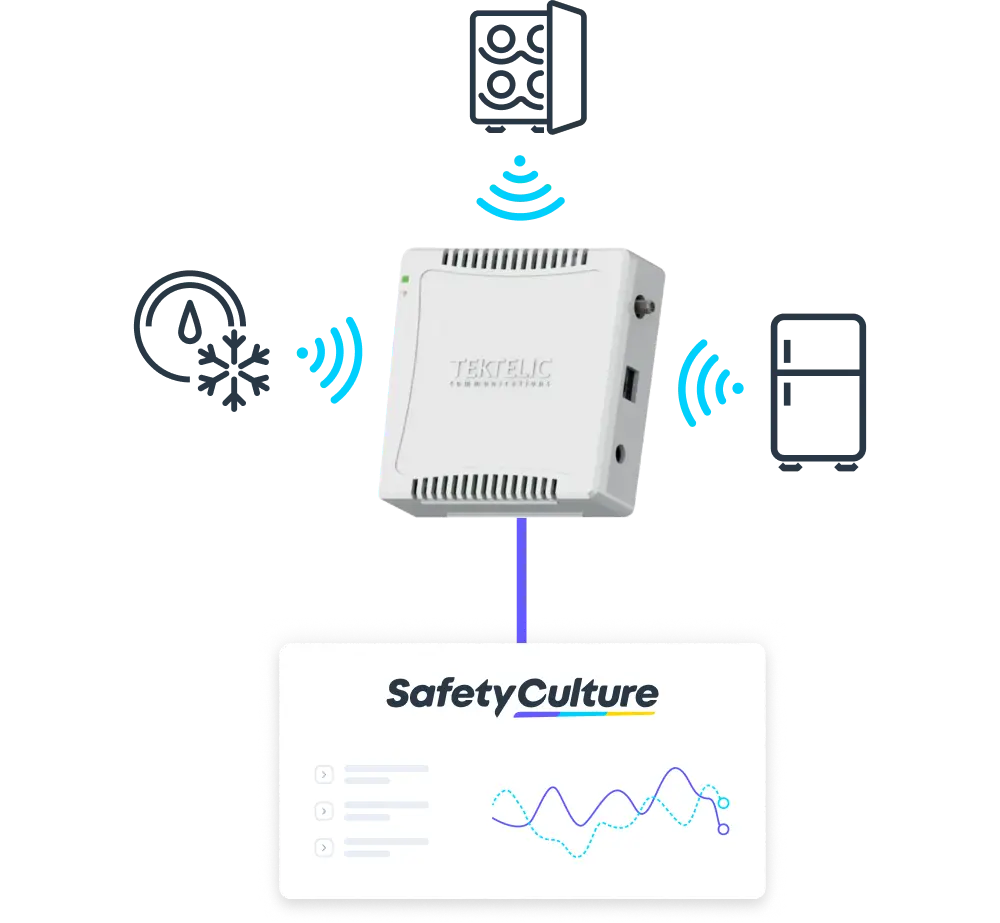What is a Temperature Data Logger?
A temperature data logger is a small electronic sensor that measures the temperature and humidity within an environment (e.g. refrigerator, freezer, chiller) over a period of time. A data logger can measure the ambient temperature of the surrounding environment and can also be equipped with a probe that can measure the temperature in a liquid or semi-solid object where you need a more accurate temperature reading. The data logger will measure temperature data at regular intervals, which can later be retrieved for data analysis.
Temperature data loggers are used in a range of industries and applications where temperature control and monitoring is critical for compliance and quality control, such as pharmaceuticals, food storage and distribution, aviation, entertainment, hospitality, and cold-chain logistics.
Key Features of a Temperature Data Logger
Key features of a temperature data logger include:
- Data Recording and Storage: Unlike a thermometer, which just gives a point in time temperature data point, a data logger records and stores the information over a period of time. The data loggers have built-in memory to allow them to store the data, which is then collected daily or weekly on a USB or similar data storage device and uploaded to a computer.
- Portability: The data loggers are small and portable and can be moved around to different locations and environments, as required by the business.
- Calibration: Data logger temperature sensors will naturally drift over time, and calibration will be required to ensure accuracy.
What are the pros and cons of using a data logger?
Pros
- Cost effective: Data logger devices are simple and don’t have connectivity requirements to gateways and software, which means they are relatively inexpensive and minimize the upfront cost requirement.
- Battery life: Data loggers don’t have to transmit data, they only store the information. This means that the battery life is typically slightly longer than a continuous monitoring data logger – although new battery technology with lithium batteries now means that continuous monitoring data loggers will last up to 3 years before requiring a replacement.
Cons
- Manual data retrieval: Although the data gets stored electronically, there is still a need to manually collect the data daily from the data logger using a USB or similar. The manual data collection process is time consuming and delays identification of temperature fluctuations.
- No ability to collect data in real time: Because data is collected manually, it is not captured in real time. While this is fine from a compliance perspective, this means the team cannot be alerted when the temperature is moving outside a controlled range and address the issue before things go wrong.
- Limited scalability: For larger scale monitoring needs, managing multiple data loggers and extracting data manually can become burdensome.
What is an Automated Temperature Monitoring System?
An automated temperature monitoring system is actually a type of temperature data logger. An automated temperature monitoring system also utilizes temperature data loggers but the data loggers transmit the data to a gateway that links the data to software in real-time to allow businesses to operationalize the information.
Key features of an automated temperature monitoring system include:
- Data Logger: The automated monitoring system also uses a temperature data logger, but the data logger is built with the ability to transmit the data in real time to a gateway. The commercial standard is using LoRa sensors that monitor and have an ultra-long transmission range. LoRa is a wireless communication protocol for IoT devices and uses low-frequency radio to send data over a much longer range than Bluetooth.
- Gateway: The sensors send temperature data to the LoRaWAN gateway which connects to the internet via ethernet or 4G cellular network.
- Software component to visualize data: The data is then processed and visualized in a software platform. This is typically accessed in a web view, but some software solutions also have mobile phone functionality that allows you to receive SMS text message, in-app notifications, and emails all to your mobile device.

What are the pros and cons of using an automated temperature monitoring system?
Pros
- Real time data recording: Data is transmitted from a sensor to a software application at regular intervals, which allows the data to be accessible in real-time.
- Remote access to data: Because the data is transmitted to a software application, typically in the cloud, the data becomes accessible to team members remotely, whether or not they are on site, via web, or mobile device.
- Operational visibility for the entire team: 24/7 real-time data access allows a business to set immediate alerts and notifications when there is a breach of set temperature ranges, which enables timely interventions. Typically access to this data can be given to everyone. In some instances, businesses have the ability to set alert escalations to different people and managers to ensure that no alerts are missed.
- Data analysis: With aggregated data from multiple sensors, automated systems can do advanced analytics and reporting which makes it easy to identify trends and drive predictive maintenance on assets and equipment from changes to the temperature patterns.
Cons
- Higher cost: Due to the real time data and connectivity and software functionality, automated temperature monitoring systems typically require a higher investment because of the operational value they create. Some solutions offer a rental or opex only model that spreads the upfront cost over a longer period of time to reduce the upfront investment.
- Connectivity dependence: Because data is transmitted frequently, automatic systems require stable connection between data loggers and the internet gateways. This can sometimes be challenging in remote or difficult environments, but can be managed with a variety of connectivity mediums, including ethernet, 4G cellular and wifi.
Explore SafetyCulture Monitoring Solution
Utilize advanced sensor technology to monitor assets, automate vital alerts, implement actions, and report urgent issues.
Talk to an expertWhat is the Right Solution for my Business?
Ultimately the choice between a basic temperature data logger and an automated temperature monitoring system will come down to business factors like the scale of your operations, budget, and the value you see in getting real-time operational visibility and actionability. Used the right way, temperature data can have a material impact on your operational performance.
Choose a solution that you can use easily from the get-go, all while being cost-effective and reliable. Each business has its own needs to consider, and different solutions may address different pain points.
Watch this video on how choosing the right solution can help your business:



